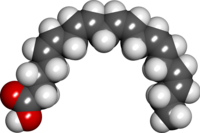Eicosapentaenoic acid
 |
|
| Names | |
|---|---|
|
IUPAC name
(5Z,8Z,11Z,14Z,17Z)-5,8,11,14,17-icosapentaenoic acid
|
|
| Identifiers | |
|
10417-94-4 |
|
| 3D model (Jmol) | Interactive image |
| ChEBI |
CHEBI:28364 |
| ChEMBL |
ChEMBL460026 |
| ChemSpider |
393682 |
| DrugBank |
DB00159 |
| ECHA InfoCard | 100.117.069 |
| 3362 | |
| UNII |
AAN7QOV9EA |
|
|
|
|
| Properties | |
| C20H30O2 | |
| Molar mass | 302.451 g/mol |
|
Except where otherwise noted, data are given for materials in their standard state (at 25 °C [77 °F], 100 kPa).
|
|
|
|
|
| Infobox references | |
Eicosapentaenoic acid (EPA; also icosapentaenoic acid) is an omega-3 fatty acid. In physiological literature, it is given the name 20:5(n-3). It also has the trivial name timnodonic acid. In chemical structure, EPA is a carboxylic acid with a 20-carbon chain and five cis double bonds; the first double bond is located at the third carbon from the omega end.
EPA is a polyunsaturated fatty acid (PUFA) that acts as a precursor for prostaglandin-3 (which inhibits platelet aggregation), thromboxane-3, and leukotriene-5 eicosanoids. Studies of fish oil supplements, which contain EPA, have failed to support claims of preventing heart attacks or strokes.
It is obtained in the human diet by eating oily fish or fish oil, e.g. cod liver, herring, mackerel, salmon, menhaden and sardine, and various types of edible seaweed and phytoplankton. It is also found in human breast milk.
However, fish can either synthesize EPA from fatty acids precursors found in their alimentation or obtain it from the algae they consume. It is available to humans from some non-animal sources (e.g. commercially, from microalgae, which are being developed as a commercial source). EPA is not usually found in higher plants, but it has been reported in trace amounts in purslane. In 2013, it was reported that a genetically modified form of the plant Camelina produced significant amounts of EPA.
...
Wikipedia
